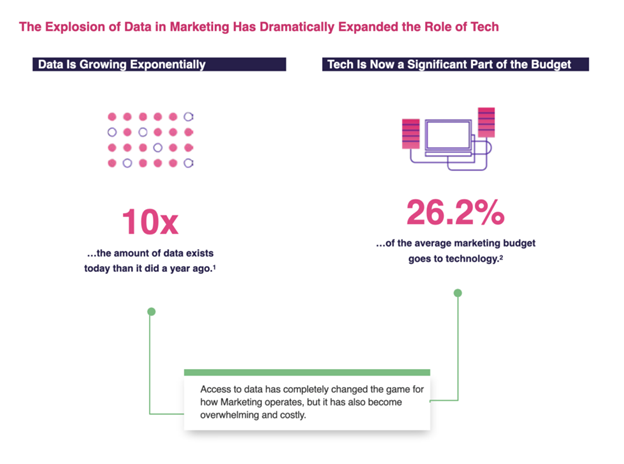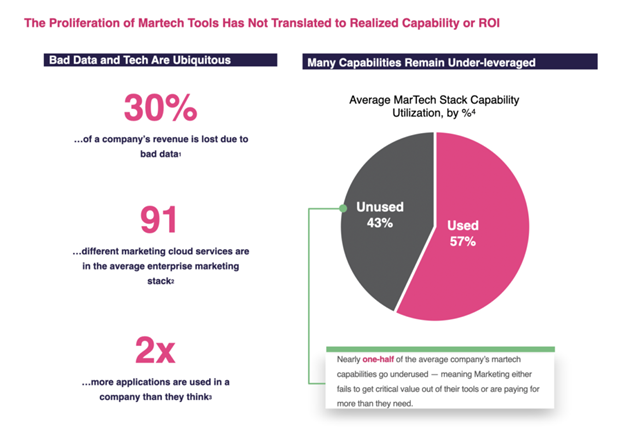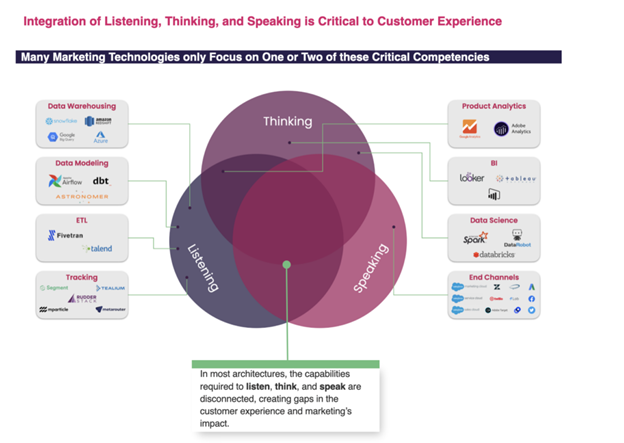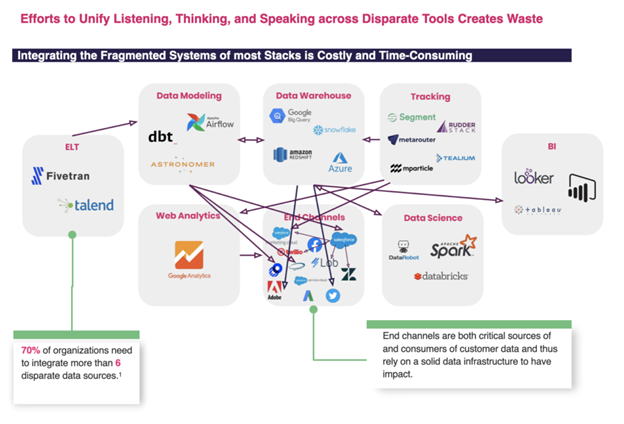State of the Marketing Stack: Thriving in a Data-Driven World
April 8, 2021You can also find this article on the Simon Data website: https://www.simondata.com/state-of-the-stack-marketing-in-a-data-driven-world/?utm_campaign=marketing-stack&utm_medium=partnerships&utm_source=cdp institute&utm_content=blog
Marketing is no longer traditional print and TV ad placements with spray-and-pray brand initiatives. Nowadays, brands turn to complex marketing stacks to navigate the digital dance of listening for data, thinking against a strategy, and speaking with customers.
An exponential amount of data is created every day that — with the proper marketing stack tools and strategy — can be tapped, mined, and leveraged by brands to make better decisions about their marketing and provide unique and valuable customer experiences.
To do so, marketing teams are dedicating a significant amount of their annual budgets to building and maintaining their martech stacks.

- 10x the amount of data exists today than it did a year ago.
- 26.2% of the average marketing budget goes to marketing technology.
Access to data has completely changed the game for how marketing operates, but it has also become overwhelming and costly.
Marketing in a Data-Driven World
Martech selection and management are more difficult than ever as martech has become a booming industry, with marketing leaders everywhere looking to amp up their marketing stacks to keep up with competitors and rising customer expectations.
- Market Pressure
- Competitive positioning is a driver of stack development as each brand tries to not only close the gap with their peers in the market but exceed it.
- Internal Pressure
- Brand leaders often feel pressure from the C-suite to deliver. Caught between a rock of limited resources and a hard place of needing to demonstrate ROI, Marketing leaders struggle to establish a solid martech stack strategy.
- Customer Pressure
- As customers go more digital, brands face increasing expectations to meet customers where they are, pushing brand leaders to acquire new technologies aimed at enabling new-in-kind initiatives.
From 947 to 8,000+ in just six years, the martech landscape has expanded exponentially, creating an opportunity and pressure for marketing stacks to grow and for marketers to become overwhelmed.
Over Stacked, Under Leveraged
While marketing technology is critical to today’s marketing function, it has become acutely overwhelming. Enterprise stacks have accumulated layers over the years, leaving teams often not even knowing what lives in it.
Shiny Object Syndrome
- Marketing stacks grow when new tools are selected because it’s what ‘everyone else has,’ or because they promise to solve a particular surface-level pain point.
- However, the addition of new tools can often create new problems.
Large martech stacks are not just expensive to acquire, but they also have several recurring costs such as:
- Lost revenue due to bad data
- Technical debt associated with maintenance, upgrades, and missed opportunity from versioning
- Staff up-skilling and external support

Bad Data and Marketing Technology are Ubiquitous
- 30% of a company’s revenue is lost due to bad data (Gartner, 2019).
- 91 different marketing clouds services are in the average enterprise martech stack (Scott Brinker, 2019).
- 2x more applications are used in a company than they think (Blissfully, 2019).
Many capabilities remain under-leveraged
The average marketing stack capability utilization, by % (Gartner, 2020)
- Unused, 43%
- Used, 57%
Nearly one-half of the average company’s marketing stack capabilities go underused — meaning Marketing either fails to get critical value out of their tools or are paying for more than they need.
Listening, Thinking, and Speaking Out of Turn
Marketers have built their stacks to be customer-centric, but most marketing technology only focuses on one or two of the essential elements of strong customer experience:
- Listening: Tools to collect data from customers.
- Thinking: Tools that process data, generate insights, and support decision-making.
- Speaking: Tools that allow brands to connect and engage with customers across their lifecycle.
Given that best-in-class customer experiences depend on marketers being able to operate at the intersection of these three elements, stacks that fail to seamlessly integrate these elements are doomed to underdeliver.

In most architectures, the capabilities required to Listen, Think, & Speak are disconnected, creating gaps in the customer experience and marketing’s impact. Disconnected systems cause teams to under-leverage large portions of their marketing stacks’ capabilities.
Fragmented data workflows are high-maintenance for teams at best and generators of a poor customer experience at worst. Disintegrated technology can cause missed opportunities through a slow turnaround, misaligned data points, and low-leverage insights.
And too often marketing stacks have overlapping capabilities that not only exacerbate the fragmentation but deepen redundancies.

- 70% of organizations need to integrate more than 6 disparate data sources. (Ventana Research, 2020)
- End-channels are both critical sources of and consumers of customer data and thus rely on a solid data infrastructure to have an impact.
Finally, the data flow is hindered by not having the right tools with the right connections keeping them from having the right impact on marketing’s key initiatives.
Workflow is hindered by slow manual processes that take up both marketer resources and speed to market. The customer experience is directly impacted by how a brand listens to customers’ behaviors and preferences, thinks about the right content for them, and speaks to them in the right place and at the right time.
Marketing’s Biggest Data Pain Points Stem from Gaps in Marketing Stacks
Data Flow
- Siloed Data
- No central location for all data to live
- Unable to unify data effectively
- Seamless identity and personalization is difficult
- Slow Data
- Difficulty matching real-time data to profile data
- Refresh rates too slow.
- Data Volume
- Imbalanced data storage causing data loss
- Too much data to process in a timely manner
Workflow
- Inaccessible Data
- Cross-functional silos and red tape
- Roles and responsibilities
- Manual Processes
- Pulling data by hand per project
- Poor integrations across tools
- Coordinating across teams
- Orchestration
- Managing the rollout across end-channels
- Balancing experimentation
Customer Experience
- Experience Gaps
- Content doesn’t resonate
- Disconnects between online and offline experience
- Misalignment between business unit engagements
- Missed Opportunities
- Marketing engagement arrives too late
- Missed identity resolution across channels
Join us next week as we highlight the ways that a streamlined and optimized marketing technology stack can improve the way your team works and the way people experience and interact with your brand. In the meantime, if you’d like more information, check out our CEO Jason Davis’s two-part blog post on martech considerations for technologists:


